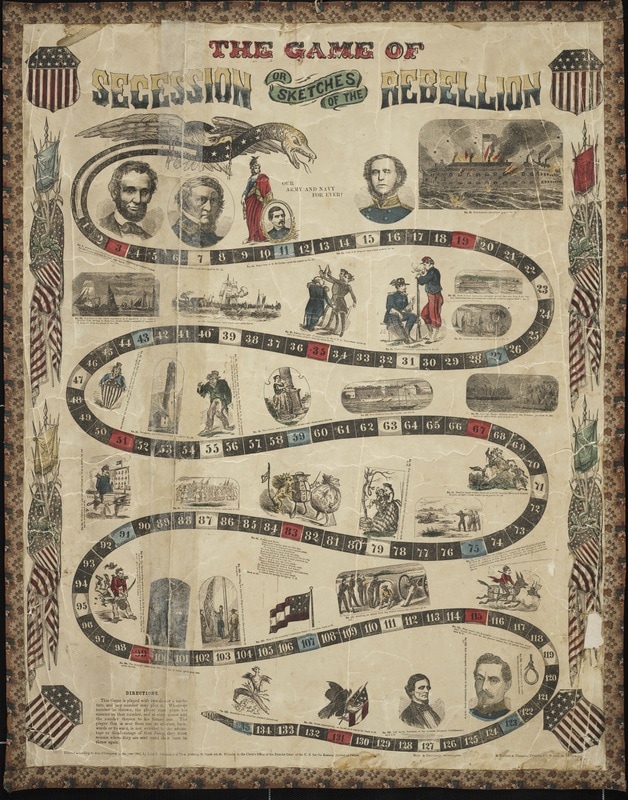By Rebecca Onion
The Vault is Slate's history blog. Like us on Facebook, follow us on Twitter @slatevault, and find us on Tumblr. Find out more about what this space is all about here.
In 1862, a year into the Civil War, the Philadelphia publishing company Charlton & Althrop registered a trademark for this optimistic and bellicose “Game of Secession, or Sketches of the Rebellion.” The four-color game board is a collage of small patriotic scenes, portraits of Union and Confederate generals, and cartoons mocking the Confederate cause.
Printed 19 years after the publication of the first board game in the United States, this game’s method of play is simple: Using two dice or a “tee-to-tum,” players advanced the number of spaces dictated by their throw. Unlike the multitude of Civil War–themed board games in today’s market, this game has no element of strategy, nor does it test the player’s knowledge of the military or political scene of the time.
Players can land on spaces that celebrate Union victories and jump ahead, or have the bad luck to land on a Confederate-themed space and be sent back. The player advancing to space 71, which depicts a Zouave Union infantryman in hand-to-hand conflict with a mounted Confederate cavalry officer, could jump 28 spaces to celebrate the Zouave’s bravery.
Meanwhile, the Confederate illustrations often mock the other side’s leaders or armies. In space 79, for instance, “Mrs. Columbia” (a stand-in symbolizing the Union) holds a little “Jeff Davis” and shows him his “Christmas Tree”—growing out of a bucket labeled “rebellion,” it’s a leafless stick festooned with snakes. Landing on this spot could set a luckless player back by 44 spaces.
The Vault is Slate's history blog. Like us on Facebook, follow us on Twitter @slatevault, and find us on Tumblr. Find out more about what this space is all about here.
In 1862, a year into the Civil War, the Philadelphia publishing company Charlton & Althrop registered a trademark for this optimistic and bellicose “Game of Secession, or Sketches of the Rebellion.” The four-color game board is a collage of small patriotic scenes, portraits of Union and Confederate generals, and cartoons mocking the Confederate cause.
Printed 19 years after the publication of the first board game in the United States, this game’s method of play is simple: Using two dice or a “tee-to-tum,” players advanced the number of spaces dictated by their throw. Unlike the multitude of Civil War–themed board games in today’s market, this game has no element of strategy, nor does it test the player’s knowledge of the military or political scene of the time.
Players can land on spaces that celebrate Union victories and jump ahead, or have the bad luck to land on a Confederate-themed space and be sent back. The player advancing to space 71, which depicts a Zouave Union infantryman in hand-to-hand conflict with a mounted Confederate cavalry officer, could jump 28 spaces to celebrate the Zouave’s bravery.
Meanwhile, the Confederate illustrations often mock the other side’s leaders or armies. In space 79, for instance, “Mrs. Columbia” (a stand-in symbolizing the Union) holds a little “Jeff Davis” and shows him his “Christmas Tree”—growing out of a bucket labeled “rebellion,” it’s a leafless stick festooned with snakes. Landing on this spot could set a luckless player back by 44 spaces.

 RSS Feed
RSS Feed